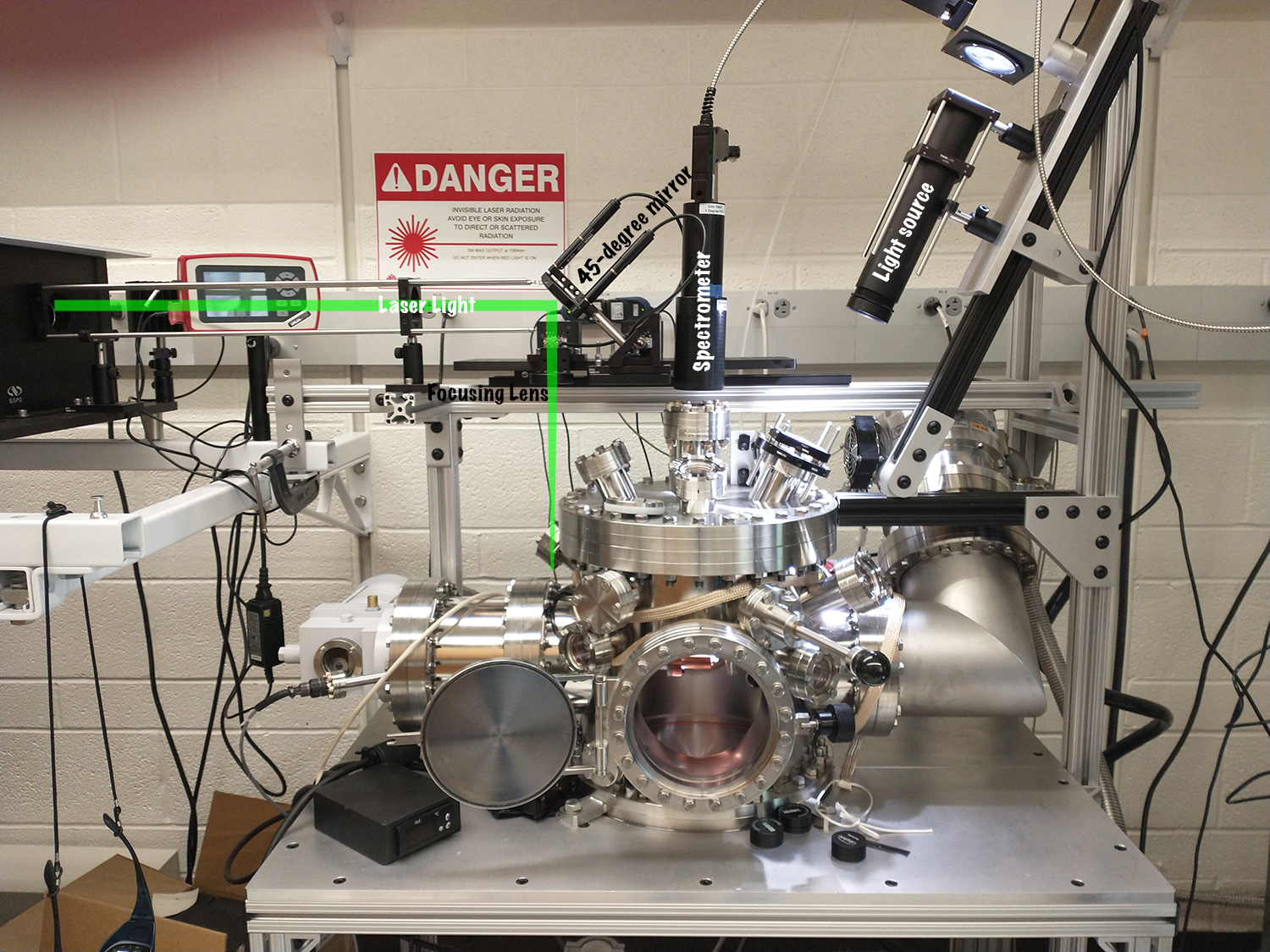Dual Laser Method for Experimentally Weathering Planetary Regoliths
- Washington University, Physics, United States of America (j.gillis-davis@wustl.edu)
Experimental space weathering—whether laser, thermal reduction, impact, or ion based—is a critical endeavor to accurately interpret space weather caused spectral alterations. Space weathering is a ubiquitous process causing the surface evolution of airless bodies. The two main processes that drive lunar space weathering are radiation effects and small-scale hypervelocity (>10km/s) impacts from micrometeoroids. Exposure to the continual rain micrometeorite impacts and ion alters the physical and chemical properties of the surface materials, which in turn changes how the materials reflect and absorb light. Reflectance spectra of mature lunar soils have lower albedo, more reddened continuum, and weaker absorption bands than those of finely ground lunar rocks.
However, linking these spectral properties observed in the remote sensing data to discrete space weathering processes is part of an ongoing, decades-long pursuit and debate. For example, latitudinal and directional dependent spectral properties variations, brightening at near infrared wavelengths in permanently shadowed craters, and the association of magnetic fields with bright swirls and dark lanes. Furthermore, while changes to visible and near infrared reflectance properties are the most prominent spectral changes, other wavelengths are also impacted. UV spectra have been shown sensitive to the very earliest effects of space weathering, and weathering effects are apparent even in the thermal wavelength range. Hence, the intent of conducting experimental weathering under systematically controlled conditions is to link specific spectral changes to chemical and physical changes in the soil.
Micrometeoroid impacts at the velocities experienced on the Moon result in substantial melting and vaporization of target soil particles. Pulse laser weathering experiments intend to simulate melting and vaporization of target materials induced by micrometeorite impacts. Typically, a Nd-YAG laser with a wavelength of 1064 nm and pulse duration 6–8 nsec and energy of 30mJ is used in experiments. These energies and durations are considered comparable with a real micrometeorite bombardment timescale (where a shock wave by a micrometeorite with a velocity 10 km/s propagates through the particle size 10 μm ∼1 nsec (Yamada et al. 1999). This energy deposition rate (1010Wcm-2S-1), however, causes vaporization and ion formation without much melt formation. The impact heating event of real micrometeorite event is orders of magnitude longer than the shock. Hence, nanosecond pulse laser heating does not produce enough melt to create agglutinate-like features. Consequently, the spectral effects produced by the short-pulse laser experiment did not match the spectral features and trends of lunar samples.
Agglutinates are generally small (<1mm) aggregates of soil grains (e.g., rock, mineral, and even older agglutinates) welded together by impact-melt glass. Agglutinates form when a micrometeorite, a millimeter or less in size, strikes the lunar regolith. In a mature regolith, agglutinates comprise the major constituent, making up 60-70% of the soil by volume. Because of their difference in physical, chemical, and spectral properties, agglutinates obscure the original composition of rock fragments derived from bedrock in lunar soils. Hence, a major hurtle for short-pulse laser space weathering is its inability to accurately reproduce the spectral and physical characteristics of mature regolith, which stems from its inability to create agglutinates.
The laser space-weathering laboratory at Washington University uses two Continuum Surelite I-20 Nd:YAG lasers with a fundamental wavelength at 1064 nm that operates from 1-20 Hz pulse rate. The pulse width of the first laser is 6 ns and for the second laser the pulse width 100 ns. The purpose of the dual laser system is to recreate the entire thermal event of a micrometeorite (particle of 1x10-12 kg or 10 µm in diameter) impact. The shorter pulse laser creates vapor while the longer pulse laser creates melt and agglutinates. The laser spot size of both lasers is ~250 μm, which deposits incident energy between 5 mJ and 220 mJ onto the sample, which reproduces impact energies of micrometeorites from Mercury to the asteroid belt. Samples are laser irradiated under vacuum at pressures of 10-9 Torr. Sample temperature can be controlled between 20K and 400K with a Helium Compressor and coldhead.
This novel method creates agglutinates, which more faithfully recreates space weathered soils. Further, spectra of materials irradiated with the dual laser method exhibit lower albedo and reduced spectral contrast compared to materials only irradiated with the short pulsed laser, which better matches spectra of lunar soils. Future work will compare and contrast chemistry and magnetic measurements between dual laser weathered samples and naturally weathered samples. Once we are convinced that dual laser weathering of lunar-like materials a room temperature produces the multitude of effects observed in Apollo regolith from equatorial regions, we will vary environmental parameters to make conditions more polar-like. While regolith at the lunar polars is, in principle, similar to the equatorial regolith. However, remote sensing data indicate that polar regolith may have different physical, spectral, and potentially chemical properties. Hence, the next steps with dual laser weathering method is to investigate the effects that temperature and the presence of volatiles have on the physical/spectral properties of regolith exposed to micrometeorite bombardment.

Figure 1. Dual laser weathering chamber and reflectance spectrometer facility. Light from both lasers is redirected down in to the UHV stainless steel chamber. As the light is redirected, it is focused on to the sample. The mirror is on pan and tilt actuators, which allow the laser light to be directed in X and Y. The shock wave generated from the laser plasma gardens the loose powder. Together, steering the beam and the stirring cause the 0.5 mg of simulant to be uniformly weathered. The 8-inch door to the chamber is open showing the sample holder. The holder is attached to a Trillium helium closed looped coldhead with dual temperature readout. The Osaka turbomolecular pump is on the right side.
How to cite: Gillis-Davis, J.: Dual Laser Method for Experimentally Weathering Planetary Regoliths, Europlanet Science Congress 2022, Granada, Spain, 18–23 Sep 2022, EPSC2022-1193, https://doi.org/10.5194/epsc2022-1193, 2022.

